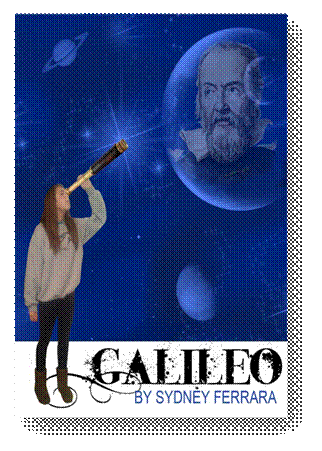
Home | About Us | JCPS Home | EHS Science Video
- Chemistry Topics: 1) Matter and Measurement, 2) Atoms, Molecules, and Ions, 3) Stoichiometry, 4) Aqueous Solutions, 5) Thermochemistry, 6) Periodic Properties, 7) Solids, Liquids, and Gases, 8) Chemical Bonding, 9) Molecular Geometry, 10) Properties of Solutions, 11) Chemical Kinetics, 12) Chemical Equilibrium, 13) Acid-Base Chemistry, 14) Thermodynamics, 15) Electrochemistry, 16) Nuclear Chemistry
Galileo Galilei
Sydney Ferrara
2nd Period
 Galileo was born on February 15, 1564 in Pisa, Italy. He died on January 8, 1642 in Florence, Italy. Galileo first studied Euclid's Element in Florence under the court mathematician Ostilio Ricci. His father, Vincenzo Galilei, was a musician. He went to the Jesuit Monastery at the age of twelve. The academy he attended was called the Lyncean Academy.
Galileo was born on February 15, 1564 in Pisa, Italy. He died on January 8, 1642 in Florence, Italy. Galileo first studied Euclid's Element in Florence under the court mathematician Ostilio Ricci. His father, Vincenzo Galilei, was a musician. He went to the Jesuit Monastery at the age of twelve. The academy he attended was called the Lyncean Academy.
Galileo went to the University of Pisa, Italy (Age 17) – while there he formulated the isochronisms of the pendulum while watching the oscillations of a lamp in the cathedral of Pisa. According to legend, he watched a suspended lamp swing back and forth in the cathedral of Pisa. However, it was not until 1602 that Galileo made his most notable discovery about the pendulum - the period (the time in which a pendulum swings back and forth) does not depend on the arc of the swing (the isochronisms).
Eventually, this discovery would lead to Galileo's further study of time intervals and the development of his idea for a pendulum clock. One of his major accomplishments was Physics. Galileo proved that all objects, despite their density, fall at the same rate in a vacuum. He disproved Aristotle’s theory that heavier objects fall faster. He also developed idea for a pendulum clock and time intervals. Galileo spent time working on mechanical devices as well. He invented a water pump, thermometer, and most famous invention is the telescope. His discoveries using the telescope proved that the earth and other planets revolve around the sun. Lastly, he also studied magnets. Galileo also had several contemporaries that followed in his footsteps to build on what he had accomplished. These people were: Kepler, Descartes, Gassendi, Bacon, Gilbert, Mersenne, and Tycho Brahe.
Sources: